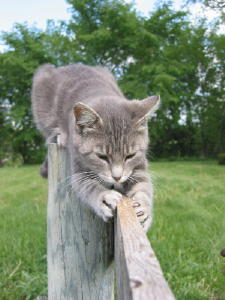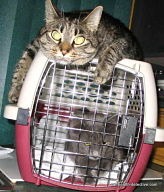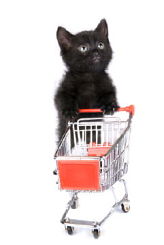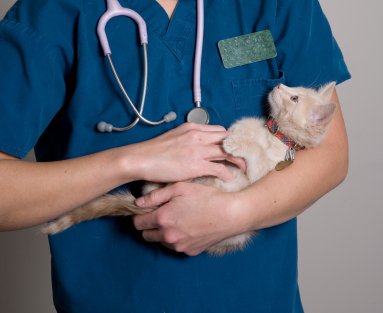Diabetes in Cats

A sign of diabetes in cats ...a fastidious cat urinates outside the litter box, a cat with a healthy appetite eats a little more but loses a bit of weight, or a cat has increased fluid intake and more frequent urination...these are the symptoms. Although there is no strict profile for diabetes, a large percentage occurs in older (about 10 years of age), slightly overweight cats.
Feline diabetes is similar to human diabetes. Two types of feline diabetes exist. Diabetes Mellitus or Type I diabetes (insulin dependent diabetes) is a true lack of insulin. The cells that produce insulin in the pancreas aren't there either congenitally or from a disease.
Type II diabetes (non-insulin dependent diabetes) is compared to adult onset diabetes in people. Causes of Type II diabetes include excessive treatment with steroid medications and other unknown factors.
Diabetes Mellitisis is more prevalent in cats, representing 70% to 80% of cases. Treatment with oral medications can be effective in 20% to 30% of cats with Type II diabetes. Oral hypoglycemic agents such as "sulfonylureas (Glipizide and Glyburide) are effective in approximately 20% to 30% of cats over the long term and up to 50% for short term usage and have been used to treat diabetes in cats for a couple of decades.
Cats can sometimes be supported for long periods of time using dietary changes along with medical treatment. Of course, it is preferable to start treatment for diabetes in cats with insulin and then try to maintain the cat later without the insulin if possible.
The pancreas releases insulin in order to help cells absorb sugar converted from carbohydrates. Ingesting too much carbohydrates causes spikes in blood sugar, overworking the pancreas.
When the pancreas cannot secrete enough insulin and blood sugar levels stay high, "Type I" also called Diabetes Mellitus happens. If the body becomes insulin resistant due to weight gain, then it blocks sugar from entering cell walls and "Type II" diabetes results.
The main reason is that cats convert proteins and fats into energy, but not carbohydrates. Cats need a diet containing only 3-5 percent carbs, tolerating up to 10 percent. Some dry cat foods contain up to 50 percent carbs.
However, with diabetes in cats, if you are giving the cat the same amount of insulin , but reducing carbohydrates intake, this may cause a dangerous condition called "hypoglycemia" or low blood sugar. Consult your vet before changing the cat's diet.
The best way to monitor diabetes in cats is to learn to monitor blood sugar at home using a blood glucose meter. Half of the owners learn readily and the other half take a little longer to master the task. Purchasing one of the newer blood glucose meters that require very small blood samples is best.
It can be difficult to get blood from a cat because they tend to move around a lot during the blood drawing process which makes it critical that whatever blood you can get is utilized quickly.
Spend a few dollars more and get a good glucose meter, such as the One Touch (tm) glucometer. Over the long run it's worth it for ease of use. However, any of the glucometers that you can buy at your pharmacy will work. Remember that the price of testing over the long run is mainly the price of the test strips.
If cost is a factor in your decision then check for a glucometer with the most economical strips. Amazon is a good online source for testing and insulin products...see below.
Many vets use a 27 gauge needle as the "stylet" to prick a vein with. This is such a small needle that it is not uncomfortable for the cat when the artery or vein is poked with it. Shine a light like a flashlight through the ear with the light held against the un-haired part of the ear. Then prick directly into one of the visible blood vessels.
This produces a small drop of blood that is easy to pick up with a siphoning blood stick or with a disposable dropper, then it is placed on the test strip. If your cat has long hair you can use a gel like Vaseline to hold the hair down prior to doing this.
The major advantage of testing at home is that it allows a blood glucose curve to be evaluated. A blood sugar test is done every 2-4 hours for 12-16 hours and this allows you to tell if there is an over-dosage or under-dosage of insulin. This way the insulin dose can be adjusted as needed. Every victim of diabetes in cats is different although a number of them have an average.
If you can't do blood testing because of your work schedule then work out a systematic urine testing with your vet. If there is sugar throughout the day in the urine it suggests that you are not reaching an adequate dosage. If there are times when there is no sugar at all in the urine and other times when the sugar levels are very high, it is likely you are over dosing and under-dosing.
Remember that urine testing is not perfect because all it can tell you is that at some time during the day the blood sugar was not being controlled. It doesn't have the immediate result of blood testing.
Regulating insulin dosages and blood glucose levels requires a lot of discussion between the owner and the vet. It can take a while to get the levels right. There are a few diabetes in cats examples that are simply difficult to regulate but it is nearly always possible to regulate insulin when a determined effort is made.
Choosing the type of insulin to use can be confusing. A human NPH insulin, either Humalin N (RX) or Novalin NPH (Rx) are widely available and work fairly well. Some are derived from insulin from other animals such as beef, beef-pork, or pure pork insulin; others are the same as human insulin.
A choice of initial insulin is generally based on the vet's preference. A cat who doesn't respond to a specific insulin may eventually need to change insulin types, as differences in the insulin types exist. Beef insulin is much closer to cat insulin and cats tend to react better to the animal-based insulin.
However, human insulin are somewhat easier to obtain. Insulin are also categorized by short and long-acting types. The most recommended insulin in veterinary research as of Dec. 2009 are Lantus (glargine) and Levemir (detremir).
Insulin and other diabetic supplies aren't cheap and refrigeration is recommended for all insulin. So that you don't waste any you may want to try injecting an orange with an empty syringe as practice. Also, it's a good idea to combine the injection with feeding time because insulin should not be given on an empty stomach in case it results in a hypoglycemic episode.
So, once your cat has finished his meal is a good time to do the injection. Most cats don't mind the shots. You give the shot at the neck region, gathering the skin up, and try to inject with the needle parallel to the body of the cat.
Some diabetes in cats animals are overweight and the vet may suggest a high-fiber prescription diet. Since the food is usually purchased in cases or large bags, most vets will let you try it on your cat to see if they will eat it. If you have a multi-cat household it won't hurt another cat sneaking a meal of it.
The diet helps in glucose regulation, transit time of food, and the amount of insulin given as well as reducing weight. Studies have shown improvement in glycemic control when cats are fed diets containing increased fiber but in cases where the diabetes is caused by chronic pancreatis, treatment for the pancreatis is sometimes a low fat diet.
Regulation is the process of finding the right dosage in insulin to administer to keep the blood sugar at a recommended level. While a normal cat's blood glucose is usually within a range of 80 to 120, veterinarians prefer a diabetic cat's sugar level to be between 150 to 180 to minimize the risk of hypoglycemia.
But regulation is not always easy. Regulation methods include periodic blood and urine testing. Many owners are capable of doing this at home while others have their vet do it.
Most important parameters to evaluate when monitoring diabetes in cats
are whether clinical signs have improved, the results of physical
examination, and the status of body weight. A well-controlled cat
should be active and interactive with family members in the home and
shouldn't have excess water consumption or urination, should have a
stable body weight, should be grooming itself, should not have rear limb
weakness, and should be otherwise normal on physical examination.
Vets rely on glucose curves only if the cat is symptomatic, develops complications or has high serum fructosamine concentrations. Glucose curves provide the necessary information to identify the underlying reason for poor control and provides guidelines on how to change an insulin treatment regimen to improve glycemic control.
The urine testing can be a challenge and some owners suggest simply following your cat to the litter box and placing one of the keto-diastix (color coded strips used to test urine for levels of ketones and glucose) directly under the flow. You can place a clock with a second hand close to the litter box so you can time the color changes as soon as the sample is taken.
With regulation and keeping the diabetes in cats pet on a monitored regimen, your cat may experience a "honeymoon", which is the term given when for a brief or extended period of time the diabetic cat doesn't require insulin.
Related Articles......
Return from Diabetes in Cats to Cat Health Homepage
Having trouble finding what you need? Cat Health Index & Site Map
OR
Do you have a question to ask?...Questions
OR
Do you have a cat story to share?...Simply click here to go to that page!
Copyright@2010-2020 All rights reserved.Cat-health-detective.com
This website is information only. Consult a veterinarian for medical assistance

"Like Us" on Facebook
or...
"Like Us" here




















